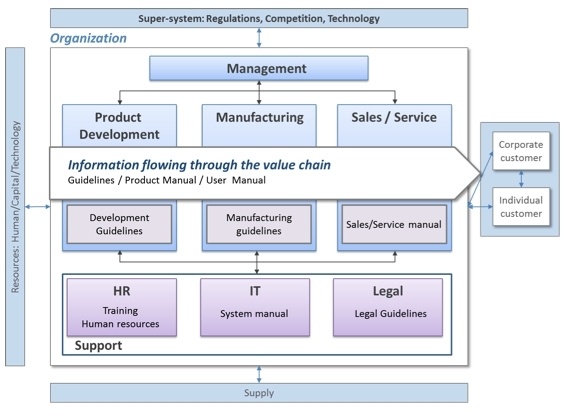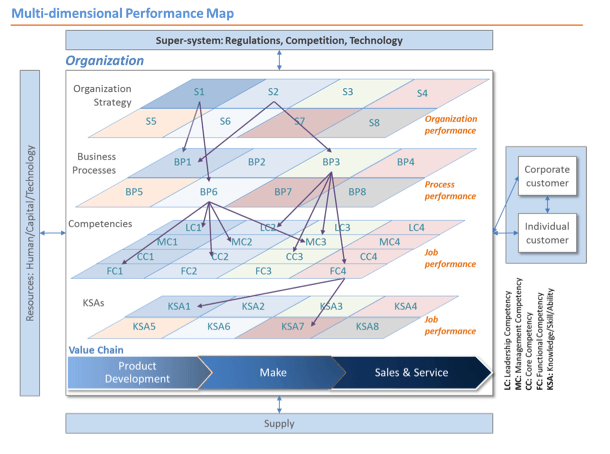Single Sourcing Design Strategy Series 2
In my previous article, “Why Does Single Sourcing Design Matter for Learning and Performance Support?”, I mentioned that it’s possible that companies unnecessarily spend a significant amount of money on managing redundant content and documents, stored in multiple teams, resulting in multiple versions for the same information. The model company I audited has been saving over $1,000,000 each year, for just the Learning and Development function, since they implemented the model, system, and workflow. The work also caught other divisions’ attention because of the consistent business process management and alignment between the processes and related resources, since all are stored in one repository, then distributed to multiple channels. Since 2009, the strategy started by the L&D department has been adopted by other departments as a knowledge management strategy.
Information Flow through Value Chain
However, as I mentioned in the previous article, it might not fit your organization’s business needs if there is no overlapped information. Therefore, identifying overlapped information among teams is the first step when considering the strategy. Let’s get out of the instructional designer’s lens here. Let’s see the big picture. Determining the necessity of the strategy requires solid understanding of information/knowledge flow, business processes, and performance architecture from the value chain perspective since the purpose is to add value to the organization and its customers. The following image illustrates how information flows from the industry to an organization and then to customers.
Information Knowledge Flow
Redundant content is generated when each vertical organization creates and updates the information, which is flowing through the value chain, in silo within their team because a significant amount of the same information is used in each team. For example, development guidelines created by the product development team are used by the manufacturing division as well as the sales division. Each division also creates their own content based on the product guidelines. If the company manages the information flow manually, e.g., sending documents via email or SharePoint, someone needs to hunt down the information in all related teams when updating the source information. When the product development team has updated part of their information about the product, for example, someone from the team needs to find all documents created in manufacturing and sales teams to update the part or inform the teams to update it. Either way, the company wastes money to update the information in multiple stores. If this is true in your case, start thinking about the single sourcing design strategy.
Multiple Processes Sharing the Same Knowledge Cross the Organization
Business processes are another factor to determine if the strategy fits your business needs. There are significant business processes that can be shared among teams. Project management is a great example. You would probably agree that a significant number of teams in an organization need knowledge and skills in the project management process. If a company manually distributes resources related to their standardized process management resources, they will face the same issue addressed above.
Performance Levels Requiring the Same KSAs
The last part to understand is the performance structure. Based on Rummler and Brache, performance should be managed at three levels (Rummler & Brache, 2013), the organizational, process, and job/performer levels. The job/performer level should be aligned with the process performance goals, and the processes should be aligned with the organizational performance goals.
To determine which part of information used by all teams or a specific team for the performance support, you need to map the cross-functional performance. Since Rummler and Brache haven’t particularly articulated the cross-functional performance map, I illustrated the map below to show how the cross-functional competencies and KSAs are aligned with the higher level performance.
Multi-dimensional Performance Map
Organizational strategies are achieved by outputs of business processes. Each process requires a set of competencies – leadership, management, core, functional competencies – that includes knowledge, skills, and abilities (KSAs) to accomplish the process goals. Mainly leadership, management, and core competencies are the ones an organization requires all of their leaders and employees to possess regardless in which department they work. Even the same functional competencies are sometimes required by multiple teams, which are called cross-functional competencies. A single sourced performance support tool contributes its value to these overlapped competencies between teams.
I pointed out three areas to investigate to determine if the single sourcing design strategy for performance support will work for your organization: Information flow, business processes, and performance levels. A thorough and careful investigation should be done before deciding to implement the strategy and the infrastructure. The next step is to design an effective information structure for the strategy. Otherwise, it will be another system sitting somewhere in your organization without being used effectively. I will cover the high-level information structure required by the strategy in the next article.
You may also find useful:
- Single Sourcing Design Strategy Series 1: Why Does Single Sourcing Design Matter for Learning and Performance Support?
- Single Sourcing Design Strategy Series 2: Determining if Single Sourcing Design Strategy Fits My Organization’s Business Needs.
- Single Sourcing Design Strategy Series 3: A Centralized Knowledge Repository Model and the structure of the Reusable Information Object (RIO) and the Reusable Activity Object (RAO).
Bibliography
- Rummler, G. M., & Brache, A. P. (2013). Improving Performance: How to Manage the White Space on the Organizational Chart (Third Edition ed.). San Francisco: John Wiley & Sons, Inc.










